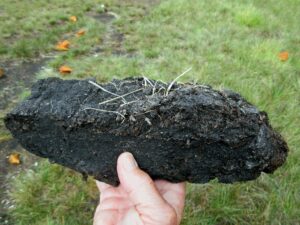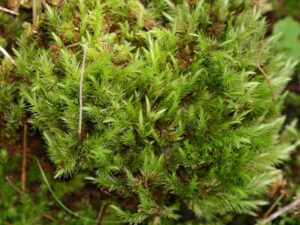Moss examples are also non-vascular plants. Mosses are bryophytes, and Bryophytes are non-flowering plants that produce spores and have stems and leaves but no true roots. Moss, usually associated with dark and humid environments, occupies many dry and sunny areas. There are over 12,000 recognized moss species covering eight classes and 23 different genera.
- Peat moss
- True mosses
- Java moss
- Sphagnales
- Taxiphyllum Barbieri
- Polytrichum
- Schistostega
- Andreaeopsic
- Pincushion moss
- Polytrichum commune
- Scorpidium
- Polytrichales
- Oedipodiopsida
Peat moss
Peat moss is an essential fibrous plant that mixes with several decomposers and different residing fabrics decompose in peat bogs and is a crucial mineral of top potting soils and seed beginning mediums. It holds numerous nutrients and moisture and then releases the moisture to the plant life roots as needed. It also has vitamins, so they aren’t rinsed out of the soil whilst you water the plant.

True mosses
True mosses are also known as Bryopsida, which contains 95% of all mosses species. Bryopsides represent a wide variety of species. The gametophyte generations have a lot in common, but they are pretty diverse. It’s a class of moss. The leafy moss plant is called a gametophore and is the adult form of the haploid gametophyte, which develops from the protonema.

Java moss
Java mosses are present in freshwater, bright green in colour and carpet-like clumps. Its stems are short (maximum 4 inches tall) and have shown slow growth, about an inch in months. Java mosses are beneficial for small fish and shrimp that require protected areas. If necessary, you can hide from larger predators.
Java moss also provides a suitable habitat for microorganisms. These microorganisms can also be a valuable food source for small fish and shrimp.
Sphagnales
Sphagnales is a type of moss with four genera: Ambuchanania, Eosfagnum, Flatbergium, and Sphagnum. The sphagnum moss contains the maximum number of species (about 200 numbers). The key to the ability of sphagnum moss species to form and grow in a flask is the vitreous cells, which are large, dead tubular cells with solid walls that can hold water.
Taxiphyllum Barbieri
Taxiphyllum Barbieri is a java moss, also known as Christmas moss, that comes under the family Hypnaceae. It is originally from Southeast Asia and is commonly present in freshwater aquariums. It clings to rocks, roots, and driftwood. In the wild, it grows in moist riverbank areas. It protects fish’s tadpoles and provides food (microorganisms, detritus) and shelter.
Polytrichum
Polystichum is a genus of moss commonly referred to as hair cap moss or hair moss, including about 70 species covering cosmopolitan distribution. Polytrichum commune has antipyretic and diuretic properties.
Haplocaldium microphyllum is beneficial for tonsillitis, bronchitis, meningitis, and cystitis. Despite its ethnographic characteristics, it belongs to the genus Sphagnum. Their use surgical bandages for better and faster absorption.
Schistostega
Schistostega pennate, also known as Goblin Gold, Glomos, or Glomos, is a moss known for its glowing appearance in the dark. This moss can grow into giant colonies in the dark and open caves in the bright green light. It has a short life cycle and can disappear in a drought year.
Andreaeopsic
Lantern moss (Andreaeopsida) is a primary group of moss that commonly grows on exposed rock surfaces. They can cling to the rock with multicellular rhizomes that dig into small cracks on its surface to secure the plant.
Pincushion moss
The Leucobryum glaucum, commonly known as leucobryum moss or pincushion moss, is a haplolepideous moss native to eastern North America. It belongs to the kingdom Plantae and is a lovely moss to keep in your garden with stones. It is easy to walk on and does not need that much water.
It provides a protective covering to several small invertebrates, examples are oribatid mites, the elongated collembolan (Hypogastruridae), and the smooth collembolan (Isotomidae).
Polytrichum commune
Polytrichum commune is a type of moss found in many areas of high humidity and precipitation. This species can grow very large as moss, with stems often exceeding 30 cm. Native to almost all continents, it is the most widely used ornamental moss in landscaping. In New Zealand, it uses as a decorative material to provide additional insulation.
Scorpidium
Scorpidium is a genus of moss in the family Amblystegiaceae. Large leaf, matte, Yellow-green, gold-green to brown-green; usually black underneath, sometimes with a green tip. The stems are upright or deciduous, over 515 cm long, and usually branched.
The information is usually suddenly pointed or narrowed to a blunt or pointed tip and sometimes pointed. Margins are flat or complex, with full or finely serrated tips. Costa is absent or weak, short and double.
Polytrichales
Polytrichaceae are a typical family of moss. Members of this family are usually larger than other moss and have thicker central stems and rhizomes. The leaves have midribs with lamella on the upper side. The species in this group are dioecious. Another distinguishing feature is that they have 32 to 64 peristome teeth in the sporangium.
Oedipodiopsida
It’s a Leaf development of Oedipodium griffithianum studied from herbarium and biological materials using various stages of development and microscopic observation of plants in a series of sections.
The apical cells lost their double-sided structure, and the leaves could develop a symmetrical leaflet pattern similar to Oedipodium protonemata. Young leaves, like most other moss leaves, never have a zone of small, actively dividing cells at the base.
Moss is a flowerless beautiful green plant specially grown on wetlands, rocks, walls and trees. There are several examples of moss used in decoration and industrial trade. Some species, such as Sphagnum, are used as indicators for mining fuel.
Also Read:
- Finger anatomy
- Is fungi prokaryotic or eukaryotic
- Do animal cells have lysosomes
- Aerobic respiration examples
- Do plant cells have centrioles
- Vascular plants examples
- Channel proteins passive transport
- Dna splicing types
- Why do plants need both chloroplasts and mitochondria
- False fruit example

Hello, my name is Kriti Singh from Agra. I have completed a post-graduation degree in Biotechnology and a B.Ed. degree. Biology is my favorite subject since childhood and I never felt tired or bored with this particular subject. As I have an inquisitive personality, always been curious and fascinated to know more about life and nature.
Let’s connect through LinkedIn: